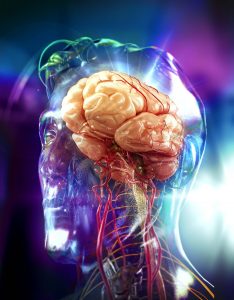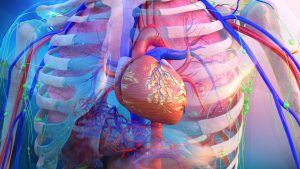Bruce Blausen, Med ’87 (MA), was an architecture student painting in a Pennsylvania cow pasture when a classmate first mentioned medical illustration. Over a pallet of watercolors, the classmate handed Blausen a brochure for a graduate program in the Johns Hopkins University School of Medicine’s Department of Art as Applied to Medicine.

“That paper touched my hand and I said, ‘That’s it. I’m going to build the human body in 3D,’” Blausen remembers.
He immediately changed majors, graduating with degrees in science and art. And though being accepted to the Hopkins program — one of only four such programs in North America — was a dream realized, Blausen wasn’t sure he could afford it.
Thanks to a scholarship opportunity, Blausen started the Medical and Biological Illustration graduate program that fall with three other students. His coursework required painstakingly dissecting the human body, learning every artery, nerve, and vein. Studying the tiniest nuances was paramount, he says. Make anything too big or too small, and the illustration morphs into a pathology.
“I literally was gifted my degree by Hopkins,” he says. “If they had not had these scholarships or this philanthropy, I wouldn’t have been able to get this degree.”
After a decades-long career building the world’s largest library of medical illustrations and 3D animations, Blausen is partnering with his alma mater to help ensure all Hopkins patients understand their diagnoses and treatment options by providing unlimited access to the Blausen Medical Library, valued at more than $25 million.
The library is home to thousands of images, animations, 3D models, and videos translated into 23 different languages, all of which will be available to the entire Johns Hopkins Health System.

“I have an opportunity to give back to the university that gave me a scholarship,” Blausen says.
Part of Blausen’s body of work is a series of short, informational videos he initially developed as a way to help his mother better understand medical conditions. She first called with questions about an angioplasty, followed by other issues, like migraines and glaucoma. Blausen quickly realized his mother was requesting easy-to-understand medical information on behalf of her friends.
“I knew no one was ever going to spend the thousands of dollars it costs to produce a two-minute video to help educate somebody like my mom,” he says. “So, I decided to build 50 topics specifically for patient education.”
The series has grown to more than 350 videos, but the desire to provide patients with accessible and easy-to-understand information remains. It’s the facet of the partnership that’s most exciting to Tom Bauer, senior director of patient and family education at Johns Hopkins Medicine. Along with his team, he is responsible for making sure Hopkins’ clinicians have the educational materials to support their patients in making informed decisions about their care, also known as health literacy.
Bauer, who started his career in health care in 1978, says the way providers educate patients hasn’t evolved much since then, though the way people learn has — more than 50% of people are visual learners. The pandemic highlighted this disconnect.

“We have to disrupt this. We have to do something different,” Bauer says. “Having access to 3D animations and illustrations is a big part of that. By providing the education the way the patients prefer, we believe we’re going to see an increased transfer of knowledge. I believe we are going to see improved outcomes, including patient and health care professional satisfaction.”
Per a Department of Health and Human Services study, nine out of 10 Americans don’t receive health information in a way they can use or understand, Bauer adds. High health literacy leads to patients feeling more comfortable making decisions with their providers. Improving health literacy can also positively impact quality outcomes, patient safety, and patient and health care professional satisfaction, in addition to decreasing the cost of health care.
Blausen hopes the partnership will expand with additional philanthropy to further tailor the existing materials to Hopkins. The end goal, he says, is to get patients back to a high quality of life. And as a Hopkins alumnus, he’s proud to play a role in advancing health literacy.
“What I am is because of Johns Hopkins and the education and the gift that they gave me,” he says. “So anything in any way that I can give back to them, I’m all in.”
Topics: Alumni, Friends of Johns Hopkins Medicine, Johns Hopkins Medicine, Strengthening Partnerships, Support Scholars